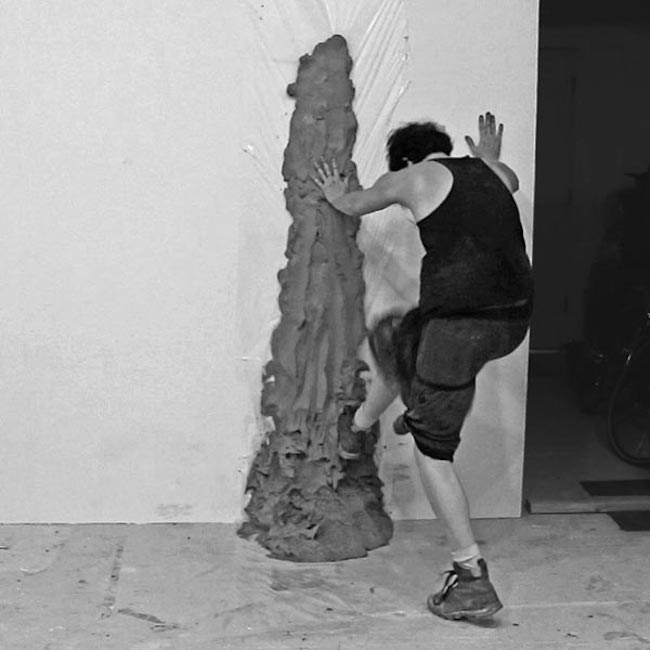Clay remembers how it’s treated. Sometimes with sensitivity, with abuse, as an equal working in collaboration with the maker, or sometimes even dominating its maker. Brooklyn-based sculptor Brie Ruais exploits this unique property to create a recorded history of her creative process.
Above image: Brie Ruais kicking her sculpture into life, 2011

Brie Ruais, Weighted by Sunset, 2010
During a period of frustration at Columbia University having previously worked figuratively with cloth and pigment (See Weighted by the Sunset, 2010 above) she turned to clay and began to lay it out and push, pull, grab, kick, stretch, and scrape it, recording her emotions. Ruais explained to Blouin Art Info that she “had this nonsensical desire to shove and spread the clay up the wall as far as I could.” She received her MFA from Columbia in 2011 and it was this piece titled The Big Push #1 250 Lbs of Clay that began a body of work which she continues today in her exhibition Dugout at t Lefebvre et Fils (Paris October 22 – December 20, 2014).

Brie Ruais, The Big Push #1 250 Lbs of Clay, 2011
Ruais’ sculptures are the reminisce of her making performance. They document her movements and emotions producing a self-portrait artifact. The actions used to make the forms happen unconsciously in an outburst of passion. “There’s this sweaty, hazy moment where it’s just me and the material, and I’m not thinking about the form or what it looks like,” she told Blouin Art Info. Imagining the act of making and source of passion leads to erotic-feeling origins for these amorphous slabs.

Brie Ruais, Two Fold, 132lbs, 2014
An important aspect of Ruais’ process is her self-imposed set of rules used when making each piece. She creates the limitations in a similar, but more casual way than Sol LeWitt’s rule-based drawings. Ruais imposes limitations on things like basic shape, action, and weight, which is often equal to her or her friend’s body weight. The piece Area Whole 300 lbs was made with 300 lbs of clay, the combined body weight of Ruais and her boyfriend.
The result of her performance is large, body-sized sculptures often with a reflective metallic finish emphasizing their weight and removing them from their clay origin. In others she exposes the clay, creating an earth pit framed in platinum or lead. They lay flat across the ground or on the wall with a sense of gravity, exactly what the clay wanted. The large pieces are sliced into grids which provide a compositional balance and separate the work into “tiles” allowing it to hang on a wall.
Ruais’ sculptures are artifacts that tell a story through what is missing. It is conceptually similar to Rachel Whiteread’s casts of the negative spaces of interiors, it is what is missing that informs the content of the work. In a similar way that Whiteread’s negative cast of a space describes the absent room, Ruais’ amorphous sculptures describe the process of how they came to be. Her actual sculptures are simultaneously unnecessary and essential to the content of the work. The work is not about the object, it is about the narrative of making, but you can’t know about the act of making without the object to lead you there.


Brie Ruais, How to Make a Vessel from the Inside, 132lbs, 2014, Galerie Lefebvre & fils
The ability to speak through what is missing requires incredible sensitivity, something I feel Ruais is doing quite well, but I feel some of herself imposed rules disrupt this design. Ruais’ “rule” determines the forms which range from vague pancakes to a specific “X” shape. Her decided shapes are iconic and are about conscious intention. These specific forms are engaging, but are in conflict with the “unconscious” making process that allows the implied narrative, an essential part of the work to be freer.

Brie Ruais, Ways of Finding Center (Scale), 2014
Her amorphous shapes, maintain a purity in concept can be visually repetitive and so lack the excitement of a confident and iconic shape. This is a tense balance throughout Ruais’ body of work, one that is being successfully addressed in her recent sculptures and exhibitions, most notably in Ways of Finding Center (Scale).
Justin Crowe is a Writer-at-Large for CFile.
Any thoughts about this post? Share yours in the comment box below.





Add your valued opinion to this post.